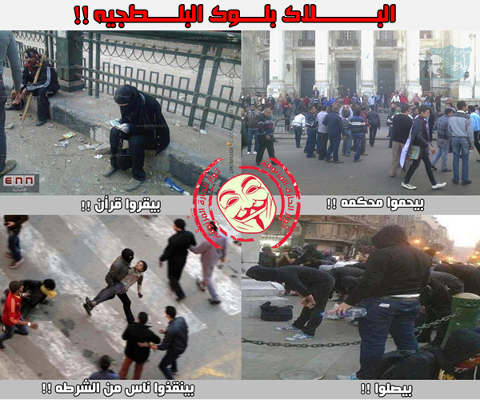
With protests in Egypt reaching a fever pitch, a new element has appeared for the first time: Black Bloc protesters using the same violent anarchist attacks against the Muslim Brotherhood that their counterparts in the United States and Europe use against capitalism.
The Black Bloc scored blows against the Muslim Brotherhood and attracted media attention but are anarchist thugs really the best way to fight Islamist thugs?
The Black Bloc Egypt group has had a Twitter account and Facebook page for a few weeks now (their motto is “Get ready for hell. Chaos against injustice.”) but really gained notice internationally during last weekend’s protests.
Freelance journalist Ghazala Irshad, whose sometimes NSFW Twitter feed is a must-follow if you want to get reports about the Egyptian riots, mentioned seeing the mask-wearing anarchists in a tweet on January 25th. Around the same time, the Associated Press reported on:
…a previously unknown group calling itself the Black Bloc appeared in a video clip posted on social networking sites. Wearing black masks and waving black banners, it warned the Muslim Brotherhood of using its “military wing” to tamp down protests, saying that if it did it would “go down to the streets and never come back.”
In another online statement, the Black Bloc claimed responsibility for attacks on the offices of the Muslim Brotherhood and a fast-food chain known to be owned by the group. Egyptian daily Al-Masry al-Youm reported that members of the group took part in Thursday’s clashes.
The opposition has demanded a suspension or radical changes to be made to Egypt’s newly adopted constitution, which an Islamist-dominated constituent assembly drafted amid deep polarization and mass street protests.
This was picked up on by the New York Times, who offered a primer on the Black Bloc:
Although largely new in Cairo, the term “black bloc” has been used for years in the United States and Europe to describe a tactic commonly used by anarchists and anticapitalists during large-scale political demonstrations that occasionally devolve into street fights with the authorities.
Participants in the bloc typically dress in black to foster a sense of unity and to make it difficult for witnesses to differentiate between individuals. Members of the bloc often blend in with larger groups of protesters, then break away, linking arms as they rush down streets.
In the United States, at least, black bloc members usually eschew violence against people but have few compunctions about damaging property.
The tactic received attention during the 1999 protests in Seattle against the World Trade Organization, when youths dressed in black broke windows and spray-painted graffiti on buildings.
In St. Paul, during the 2008 Republican National Convention, black bloc members roamed through the city smashing bank windows and using hammers to batter a police car.
In both tactics and outward appearance, the Egyptian Black Bloc shares much in common with their Western counterparts, including the use of Guy Fawkes masks seen in Anonymous and Occupy Wall Street protests.
This copycat Black Bloc opposition shows the odd symbiotic relationship between Occupy Wall Street and the Arab Spring. Occupy was inspired in part by the Arab Spring uprising and conceived as a hoped-for America uprising. Attempts at revolution were a failure, but the Occupy movement still garnered positive press and created political messaging memes that helped sweep President Barack Obama to a second term.
In the past eighteen months, the Black Bloc in the U.S gained high visibility due to Occupy and that, in turn, seems to have inspired the new Egyptian version that is garnering more press coverage.
As usual, however, the Black Bloc just ends up stirring up discontent even among it’s theoretical allies. As the AP’s Maggie Michael points out:
Their emergence has raised concerns even among fellow members of the opposition, who fear the group could spark Islamist retaliation or that it could be infiltrated to taint their movement. Islamist supporters of President Mohammed Morsi call the bloc a militia and have used it to depict the opposition as a violent force wrecking the nation.
Moreover, some Islamists have threatened to form vigilante groups in response, creating the potential for a spiral of violence between rival “militias.”
A spiral in violence certainly doesn’t seem like a rational goal, unless you’re anarchist and your avowed, explicit, and clearly stated goal is chaos. In that case, violence fits your agenda perfectly. Stirring up discontent amongst allies is also perfectly okay.

COMMENTS
Please let us know if you're having issues with commenting.